The Rotoiti/Nelson Lakes Nest Protection project has been running since 2012 and continues today.
On this page you will find the following:
- 2022 - Help us monitor kea chicks this season!
- 2021 bio-survey (a partnership between DOC and the KCT)
- Feral cat trapping programme 2021
- 2021 nest monitoring results
- 2020 kea survey, predator control and nest monitoring
- Results of nest protection work from 2011-2015
- 2009-2011 - Survey of Nelson Lakes kea
2022 - Help us monitor nesting kea
We need your help in continuing to monitor nesting kea in Nelson Lakes this season to ensure their best protection. Please visit our Givealittle page to donate - Thank you!
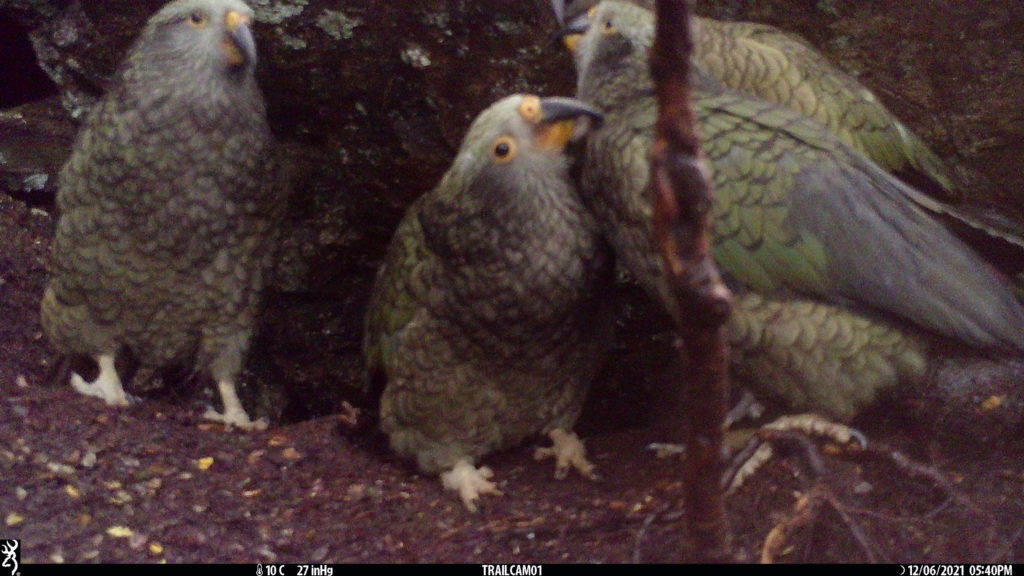
Feral Cat Trapping Programme (2022)
In the second year of this programme, the DOC St Arnaud team reactivated the live trapping network at the end of June 2022 in time to support the kea breeding season. Between the 28th June and early December, the traps were opened Monday - Friday, resulting in 9 feral cats and 3 possums being captured and removed from the system. This is a fantastic effort, providing much-needed support for the areas nesting kea (two nests are currently active).
These traps will continue to be serviced until any kea chicks hatched have fledged (January - February 2023).
2021 Bio-survey
A bio-survey was undertaken at the beginning of the year in the wider Nelson lakes area by DOC and KCT field personnel with the support of Friends of the Cobb volunteers.
- Two kea were seen and heard, one at Lake Thompson and one in the East Sabine. Neither kea came close and both were first heard then seen flying high about the survey site. Both kea were encountered during treeline surveys and none were seen or heard during the day while conducting long-term monitoring surveys.
- No rock wren were encountered during the entire trip. There was very little sign of any other alpine species that you would expect to find in the area. One fantail was seen within some ideal rock wren habitat but this individual was subsequently caught and killed by a falcon during a rock wren search.
- One gecko was found during an active search. Subsequent tracking tunnels and searches in the area failed to find any more sign of geckos.
Feral Cat Trapping Programme (2021)
In 2021, the KCT in partnership with DOC Rotoiti/Nelson Lakes have set up a network of 20 monitored live traps to target large predators such as feral cats and possums on the eastern side of the St Arnaud Range. This "Celium network" (installed by Encounter Solutions) extends the existing network managed by DOC (around Lake Rotoiti on the western side of the St Arnaud Range). When an animal enters the trap and triggers it, a signal is sent to a central hub via a node on the trap, to alert DOC rangers. The trap can then quickly be checked so that any kea inadvertently caught can be released unharmed and any feral cats or possums can be humanely euthanised.
During the first year of the networks deployment, 5 feral cats and 14 possums were caught - a huge win for local nesting kea!
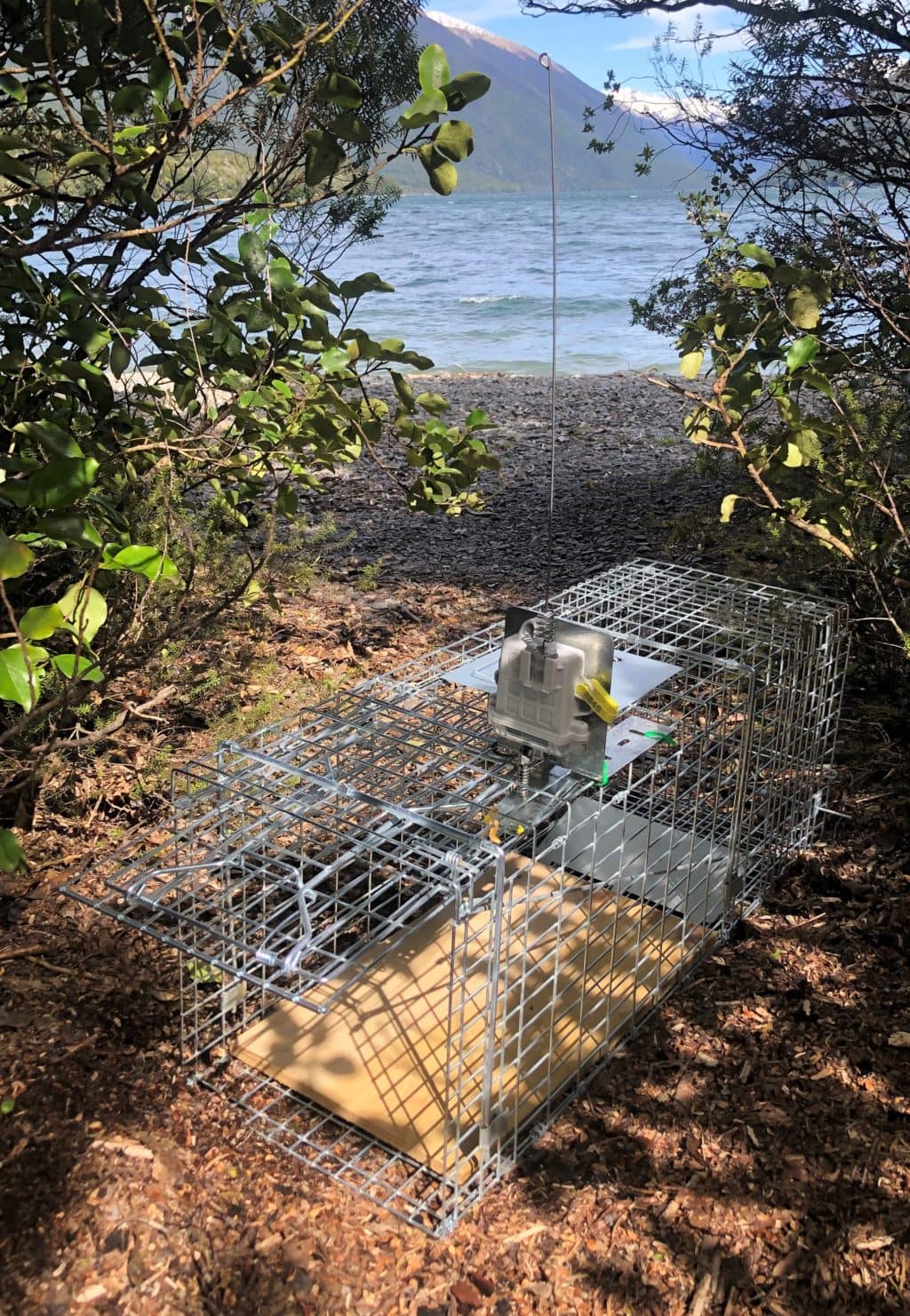
Our Nelson Lakes Trapping Sponsors
- Nelmac – $4,718 (initial set up costs)
- Thank you to all those people who helped fund our trapping network through our Givealittle page - almost $5,000 was raised as a result!
- Lady Joy Williams – $225 (complete cage trap/node/subscription package)
2021 Nest monitoring results
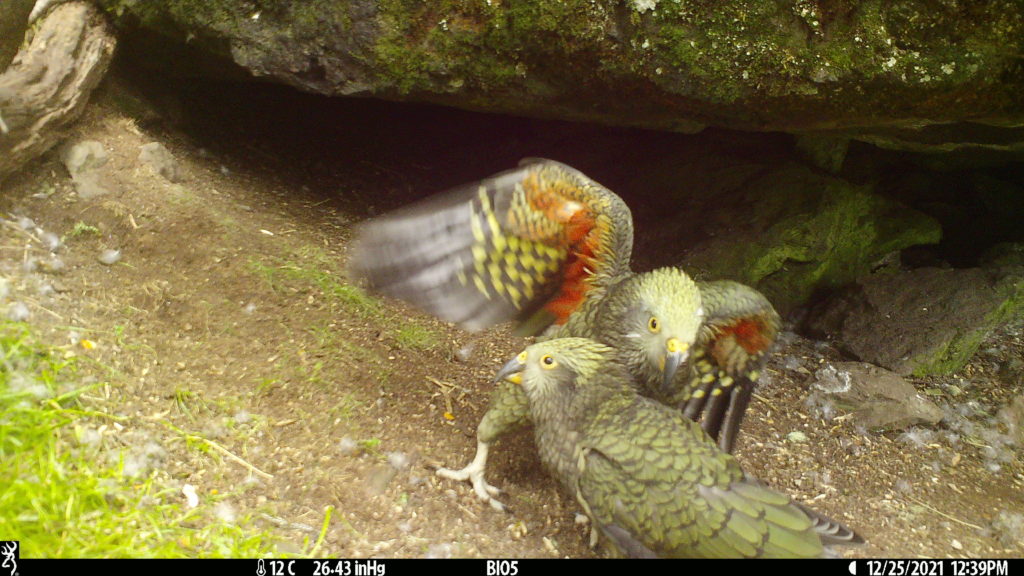
A total of six chicks fledged from two nests this season. This is the first time since 2014 where we have seen such high numbers of chicks in the area which is very exciting!
In December, 3 trips were carried out, resulting in 1 adult female and 2 of her chicks being banded.
2020 Kea Survey, Predator Control and Nest Monitoring
Funded by 21 Peaks in 21 Days, Anon donation, Mothers Day Vouchers (2019), Destination Nelson lakes, Rotoiti Water Taxis, St Arnaud Film Festival, 2019 Garage Sale (Lucy and Sylvie Kemp and Ana and Poppy Hay).
2 - 13 August 2020
A plan was put in place to re-invigorate this study site due to its historical value as a research site. The aim of the 2-week field trip in August was therefore to:
- Check occupancy and nesting activity of all known nest cavities in Nelson Lakes National Park and across the Wairau River up the Rainbow Valley.
- Install trail cameras at the entrance of any active nest cavities to monitor future visitors to the cavity, either kea or predator.
- Catch kea and fit with radio transmitters to monitor their survival during the September 1080 operation in the area as well as monitor their long-term survival.
- Monitor predator abundance.
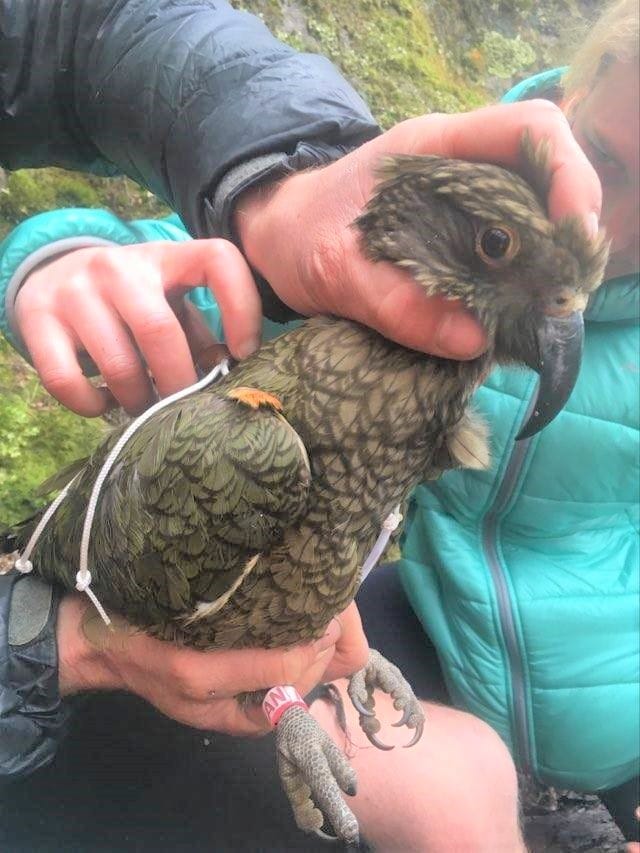
Outcomes
- A total of 36 nest cavities were checked for signs of nesting activity (34 historical and 2 new).
- Seven of these cavities showed signs of activity (from 4 breeding pairs). Cameras were set up at these sites to record activity. These are being checked every 3-4 weeks.
- Three kea were caught and transmitters attached to two males (an adult, Donnie and subadult, Tony (see photo above)). Donnies transmitter was unfortunately found chewed off and discarded outside a nest cavity 24hrs later. No transmitter was attached to the adult female (Scuffle) as she was potentially gravid.
- 150 new tracking tunnels (3 sets of 5 lines, 10 tunnels in each line) were set up by St Arnaud DOC to monitor predator abundance in areas where kea are nesting.
Predator Control
A 1080 operation was carried out by DOC across 31,549 ha of the wider Nelson lakes area in the first week of September 2020. Follow-up tracking of mustelids (stoats and weasels) and rodents show 0% of these pests while camera monitoring of cats showed a drop of 5.36 cats per 100 camera hours to 0.63 per 100 camera hours. This will hopefully bode well for our kea nesting season although unfortunately all of the active breeding adults home territories (and therefore nest cavities) are outside of the drop area.
Nest Monitoring
All nest cameras SD cards are downloaded, images checked for the presence of kea activity and predator interference and batteries changed every 3 weeks.
October – At the second check on 16 October, two of the nests were found to be active with females Scuffle (see photo at right) and Aphrodite sitting on young chicks!
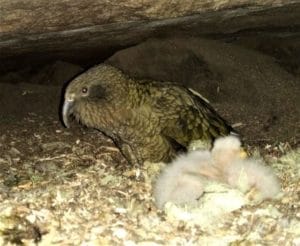
November– At the next nest check on the 2nd November, Scuffle’s chicks were still present and were getting their primary feathers. Scuffle was fitted with an egg-timer transmitter to allow follow-up nest monitoring in future years.
Unfortunately, Aphrodite’s nest had been predated and no chicks remained.
December – During the final check-in in December only one of Scuffles chicks was found to be alive with another dead in the nest. The third chick was not present. Camera footage will be reviewed and the dead chick will be sent off to Wildbase Hospital to determine the cause of death. The surviving chick was banded to enable re-sightings.
Results of Nest Protection programme 2011-2015
In order to prevent localised extinction of the breeding population, direct intervention to protect remaining resident females at nest sites during the breeding season was considered necessary. As such, a skeleton network of traps (sentinels and DOC150/200’s) was set up to protect active nest sites informally during 2011 and this was extended on a more formal basis in 2012 and 2013.
- 2011 - 4 chicks fledged from 2 nests (Ceejay (2); Unnamed – nest 8 (2))
- 2012 – 1 chick fledged from 1 nest (Aphrodite (1))
- 2013 – 3 chicks fledged from 2 nests (Ceejay (1); Rachel (2)
- 2014 (1080 operation) – 6 chicks fledged from 2 nests (Ceejay (3); Rachel (3))
- 2015 – all nests failed
2009 - 2011 Survey of Nelson Lakes Kea
Funded by 21 Peaks in 21 Days and an anonymous donor
A three-year survey of the Nelson lakes kea population carried out by the Kea Conservation Trust from 2009 – 2011 showed a decline of approximately 80% in the numbers of breeding pairs and fledgling production since the population was first studied in the 1990s by DOC and the University of Otago.
Predation of nests by introduced stoats and possums appears to be a factor in this decline and as such a programme to protect vulnerable nests during the breeding season was initiated in 2011.
Programme aims:
- To monitor numbers of possums and stoats within the project area
- To prevent possums and stoats interfering with active kea nests
- To increase kea nest survivorship and fledgling numbers.
Summary of productivity by year
A total of 8 breeding females have been followed in the Nelson Lakes area at 6 Mile Creek, on the St Arnaud Range, the Raglan Range and the Robert Range since 2009. Females include Lucy (deceased 2011), Ceejay (deceased 2014), Aphrodite, Rachel, Scuffle, Mynx and two unnamed females. Breeding adults have been fitted with vhf and diagnostic radio transmitters and tracked to ascertain location of nest sites each year (females may occupy different cavities within their territories from year to year). A total of 4 females have produced 18 fledglings across the 6 years as follows:
- 2009 – 2 chicks fledged from 1 nest (Ceejay (2))
- 2010 – 2 chicks fledged from 1 nest (Ceejay (2))